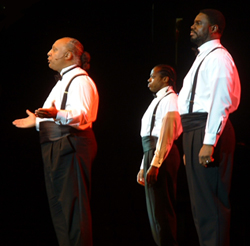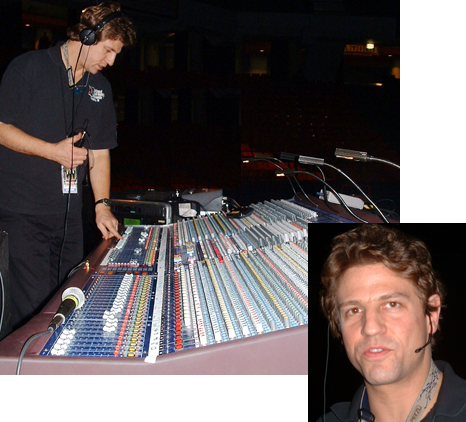
As much as playing the latest and hippist CD is a bit of a tradition with most of us, it’s a bit like a drive-by with the car radio cranked, windows down.
Sounds like a script for another The Fast & The Furious sequel: The Loud & The Ludicrous.
Nothing rattles a room (and clears your sinuses) better than a pure sine wave.
It’ll also let you know if anything is questionable in the loudspeaker system.
After all, it’s what we use to test re-cones for rubbing and bad glue jobs, so why not test a whole PA with it?
True, it doesn’t make for good relations with the crew, but for that matter, neither does that click track. It’s also a good way to clear a room of unnecessary talkers. (Why is it that the two guys talking to each other at the top of their lungs about last night’s ball game are always standing right behind the mix platform while you’re trying to EQ?)
Let’s loop back to “3 Mo’ Tenors” – the tour’s sound mixer/designer, Joshua Switky, started mixing in 1985, earning his audio wings in Western Massachusetts at the Iron Horse Music Hall in Northampton.
Interesting: Joshua used a sine wave generator and parametric EQ to flatten out the room and the rig. The more things change, the more they stay the same. Prior to the show, I talked with him about his experiences and just how he’s honed his system tuning/EQ approach.
Gary Gand: Tell us about your “childhood” in this business.
Joshua Switky: The Iron Horse booked 350 shows a year, mostly national and international acts because there are five colleges worth of audience nearby. The owner booked Shawn Colvin, Mary Chapin Carpenter and Alison Krauss long before anyone had heard of them, plus all the bluegrass and jazz greats I’d been listening to since I was a kid: Chick Corea, McCoy Tyner, Tony Williams, John Scofield.
One night would be Bill Monroe and the next would be Bill Bruford. Heaven! I got to mix almost all the shows for four years. It was hard to leave to go touring, but that led to taking jazz greats like Al DiMeola and Paquito D’Rivera around the world and was well worth it.
Gary: Your EQ process looks like a blend of “old school-new school.” How did you develop it?
Joshua: The Iron Horse was a feedback factory and presented a lot of acoustic music on a tiny stage with no PA headroom, elbow room or processing, while the audience was full of ‘helpful musicians’ who wanted a CD-quality show.
I mixed front of house and foldback from a Yamaha MC2404 and learned that real life doesn’t happen on 1/3-octave ISO centers. The Iron Horse room was tuned to ‘D.’ Every ‘D’ for five octaves went nuts. A bluegrass band drove me crazy – all those songs in ‘A’ or ‘G’ or ‘D.’ Tuning speakers and channels needed to be very precise.

